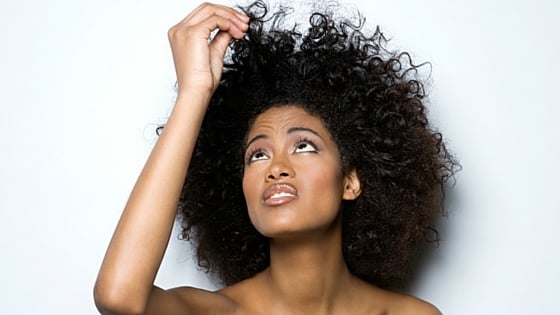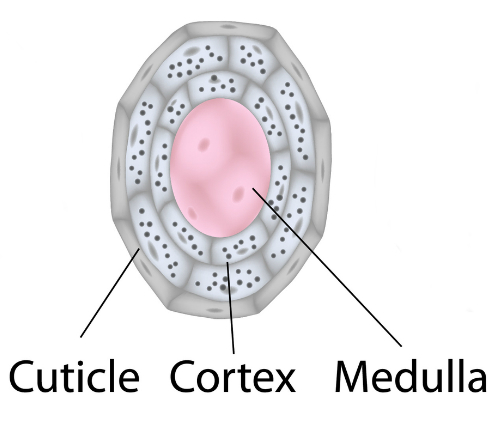Your hair cuticle challenge: Look fly, not fly-away

https://www.pinterest.com.mx/rosemarie0509/fab-hair-options/
The hair cuticle is your first line of defense, your last resort for moisture retention and your source of shine in your finished hairstyle.
Not only does the cuticle protect the cortex from undue harm, it also works overtime regulating the passage of moisture into and out of it. The cortex is at the mercy of the cuticle, with resilience or elasticity directly affected by any chinks in the armor. With such great responsibility, the cuticle has the power to make or break your hair flair.
Some say the best offence is a good defence, so let’s find out what we can do to keep our cuticle cute, cared for and under control.
But what is the hair cuticle?
The hair cuticle is the outermost protective layer of your hair strand. It is made up of a series of layered keratinized cells that work together to shield the cortex from damage. Since the cuticle has no melanin cells, or melanocytes, it does not contribute to the color of your hair.
Keratin protein cells, or keratinocytes, go through a life cycle of their own. They are produced in the hair follicle through a process of cell division and replication by the hair matrix. As the cells separate from the hair matrix, they die and are pushed up to fill the hair shaft. The dead cells harden and form various components of the hair shaft, some of which are designated to the cuticle. When referring to the cuticle, we specifically mean the shingle-like formation that builds the outer sheath.
Based on your hair type, you can expect to find a variation in the number of layers of cuticle. Not just from one head of hair to another, but also between strands on the same head of hair. In fact, on some individual hair strands, that variation can occur from one side to the next.
An average straight hair strand has 6 to 10 cuticle layers, which are applied in a relatively uniform fashion. If you’re dealing with curls, however, you may have as few as 2 cuticle layers on the inner side of the curl and up to 10 on the outer side of the curl.
Depending on which way your curl rolls, straightening of that curl may cause the less protected side of the hair strand to be exposed to the elements. This could be one of the reasons why changing someone’s natural hair pattern opens it up to exposure to more damage.
The cuticle layers point in the direction of the tip of the hair strand, which makes total sense when you think about brushing your hair. And the reason why teasing your hair creates volume. You are essentially grooming against the grain, roughing up the cuticle and simulating the expansion of your hair strand’s natural thickness.
Opening and closing the cuticle
A nice tight, smooth cuticle provides the best reflective surface for the appearance of shine and healthy hair. We often sacrifice this layer in our attempts to change our hair into styles that are not innately natural for us.
Open to possibilities
When the call for change sets in, we have to lift the cuticle to gain access to the cortex where the genetic template to our hair type lives. Opening or lifting the cuticle requires alkaline substances to be directly applied to the hair.
The easiest and most common way to lift the cuticle is to wet your hair. Water naturally has the ability to penetrate the cuticle layer and enter the cortex to cause some swelling of the hair shaft. That swelling keeps the cuticle slightly open, or ajar and allows cleansing agents and shampoos to penetrate.
On dry hair, alkaline substances open the cuticle. Relaxers, perms and hair color have an alkaline base, which is why they are applied to dry hair. When the cuticle opens, it allows for a concentrated chemical solution to enter the cortex and make changes to the curl pattern or color.
Closed for successful styling

http://beautystat.com/site/hair/how-to-tell-if-your-hair-is-damaged-and-the-best-products-to-treat-it/
Healthy hair cuticle
The issue of closing the cuticle arises after every wash day. As stated earlier, water has opened the cuticle and, depending on your wash day routine, is now waiting to be closed up to resume its role of protection.
Conditioner is said to have the necessary pH to close an open cuticle and the best ones are designed to do just that. Your hair will actually feel softer when the cuticle is laying flat, or tightly closed.
Another way to close your cuticle is cold water. A cold water rinse after conditioning is reported by some to clamp shut those cuticle layers, while others say it has no effect but to make your shower unpleasant. Let me offer some anecdotal evidence that may persuade you to try your own experiment.
Living in a particularly cold climate, I often leave the house with wet hair. I’ve always let my hair air dry as an attempt to minimize frizz. On one notable occasion it was cold enough outside to cause my hair to freeze slightly, much like when you have a sculptural gel applied. Later in the day, while inside the warm comforts of my destination, I noticed a remarkable difference in the amount of shine and curl definition. Decidedly, a great hair day. Still looking for a way to replicate this without braving an icy cold shower, but I believe the cold works.
One other alternative way to close the cuticle that may rescue you from the cold rinse option is an apple cider vinegar rinse. Apple cider vinegar is acidic and helps to balance the pH of the hair. The perfect pH for hair is 5.5 – 6.5. Urbanbushbabies.com recommends a hair rinse recipe, consisting of 1/4 cup apple cider vinegar to 2 cups of water, to achieve a closed cuticle and increase overall shine.

http://hairmomentum.com/
Do you have hair-raising cuticle damage?
Since the cuticle makes up the external layer of your hair strand, when it’s damaged you know it. Hair that feels rough to the touch, dry or brittle is more than likely suffering from a damaged cuticle. Existence of split ends provides definitive evidence of a damaged cuticle.
Damage to the cuticle happens, in part, through exposure to environmental factors, but is most likely due to personal styling practices, including chemical treatments. Damage tends to build up over time and can start out with minor chipping in the cuticle that later expands into greater weakness of the hair strand because of the gap created in the armor.
When you first see signs of split ends, the best thing to do is have your hair trimmed above the point where the split end starts. This will prevent the separation from traveling up the shaft and along the length of your hair.
Other signs of cuticle damage can be identified through hair breakage. When the cortex gets dried out, the dryness also permeates the cuticle. To look at it up close, you would see definite signs of cracking. Any point of cracking is like a fault line. This means where a crack appears, a break can, and probably will, follow. Excessive blow dryer use and hot styling tools tend to be the cause of these extreme drying conditions.
Minimize the hurt on your hair
There are a few things you can do to try to keep your cuticle in good shape. First and foremost, go easy on the applied friction. This is anything from the extreme of dry brushing to the simple act of going to bed without first covering and tying your hair down.
You may want to include some of the following practices in your hair care routine:
- Aside from covering and tying your hair before bed, use of a silk or satin pillowcase will reduce night-time friction.
- Change the way you brush or comb your hair. Try dividing your hair into smaller sections before attempting to brush out those tangles. Be gentle as you comb or brush out the knots, trying not to tear haphazardly at your mane.
- When dying or relaxing your hair, be careful to only apply the product to virgin hair or new growth. This means when you’re touching up, your product should only cover the base of your hair, close to the scalp. Any overlapping of product can create excessive damage to previously treated sections.
- Minimize excessive heat from styling appliances. Many of us use extra hot curling irons to improve the curl setting action. Experiment with your heat settings until you find the lowest one capable of giving you the outcome you’re looking for.
Porous cuticle problems
Black hair has a tendency to be porous. In curly hair, the convex side of the hair shaft has a thinner cuticle than the concave side of the same shaft. That means you can have as few as two layers of cuticle protection on the outside of your curl and the inner side will have between six and 10 layers. Fewer layers means less protection from harm and abuse.
Some porosity issues have to do with the natural curl shape and how the cuticle characteristically lays as it follows the curve. If you think about what it’s like to try to pry open a box lid that has been nailed shut, a gap beneath the nail head makes it easier to pry open. As the cuticle “shingles” follow the bend of the curled shaft, they would naturally lift a little to navigate the turn. That structural gap can allow for penetration of wayward elements and either the escape of moisture or the penetration of chemicals or environmental toxins.
The best way to combat a lifted cuticle is to use some of the hair rinsing methods outlined above to close the cuticle as tightly as possible. If excessive damage is the culprit of your porosity issues, protein treatments are essential in repairing large holes and gaps in the hair strand.
Keep in mind that applying protein is not a long term fix because the actual hair strand is dead. It may fill the gaps temporarily but will wash out easily since there are no living protein cells to fuse with and rebuild the wall.
Although you can’t change the number of cuticle layers assigned to your hair type, a more permanent improvement of cuticle strength can arise out of proper diet and nutrition. Providing your body with the right nutrients gives the hair follicle more stable building blocks to work with as it processes and produces the hair fibre.
Make it a habit to inspect your cuticle regularly. Early intervention of self-inflicted damage can spare your hair from more trauma than is necessary. Remember to get your hair trimmed regularly and often.
Have you developed any tips and tricks when working with your cuticle? Share with us your successes and failures. We’re eager to hear from you!










